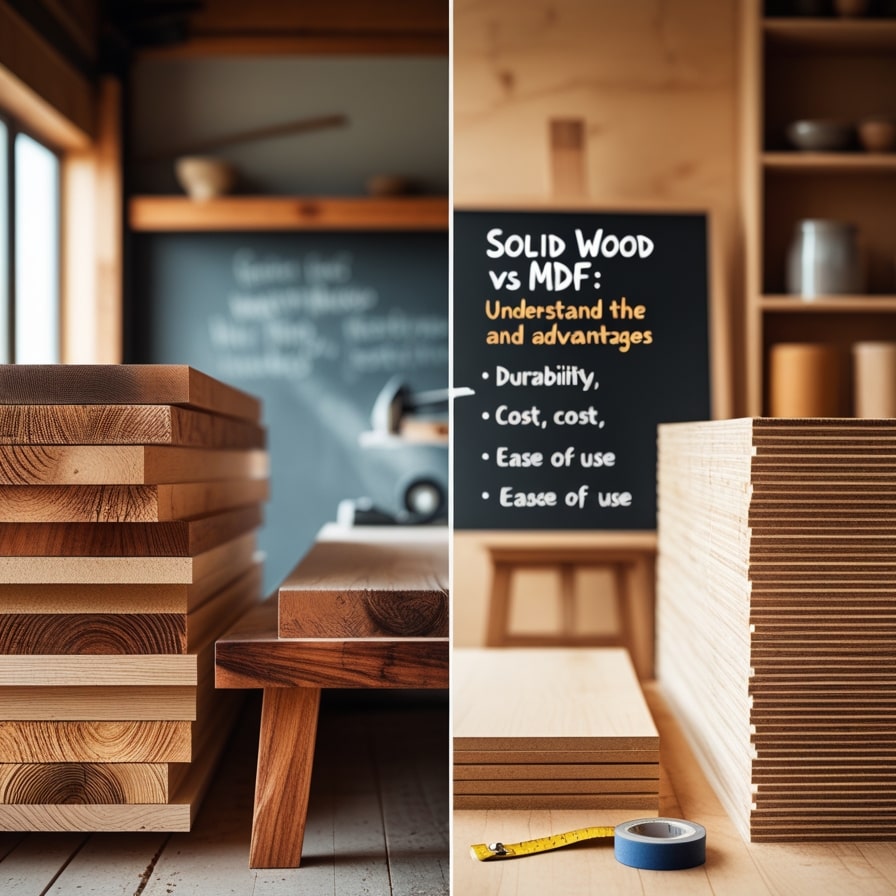When it comes to woodworking or furniture making, choosing the right material is essential. Two popular options are solid wood and MDF (Medium Density Fiberboard).
Both have their unique qualities, advantages, and drawbacks.
In this guide, we’ll help you understand these materials better so you can make informed decisions for your projects.

What is Solid Wood?
Solid wood refers to natural wood that has been cut directly from a tree. It comes in two main types:
- Hardwood: Derived from deciduous trees like oak, maple, and walnut.
- Softwood: Comes from coniferous trees like pine, cedar, and spruce.
Advantages of Solid Wood
- Durability: Solid wood is incredibly strong and can last for generations with proper care.
- Aesthetic Appeal: It showcases the natural grain, providing a timeless and premium look.
- Customizable: Can be sanded, stained, or painted multiple times.
- Eco-Friendly: It is a natural and biodegradable material.
Disadvantages of Solid Wood
- Cost: Solid wood is more expensive compared to MDF.
- Susceptibility to Moisture: It can warp or crack when exposed to humidity or temperature changes.
- Heavy: Its weight can make it challenging to handle and transport.
What is MDF?
MDF (Medium Density Fiberboard) is a manufactured wood product made by compressing wood fibers with resin and wax under high pressure and heat.
Advantages of MDF
- Cost-Effective: Significantly cheaper than solid wood.
- Smooth Surface: Ideal for painting and laminating due to its uniform texture.
- Resistant to Warping: MDF is less likely to warp or crack compared to solid wood.
- Easy to Work With: Lightweight and easy to cut, drill, and shape.
Disadvantages of MDF
- Less Durable: It is not as strong as solid wood and can sag under heavy loads.
- Moisture Sensitivity: MDF can swell and lose integrity when exposed to water.
- Chemical Content: Contains resins and adhesives that may release VOCs (volatile organic compounds).
- Limited Aesthetic: Lacks the natural grain and beauty of solid wood.
Key Differences Between Solid Wood and MDF
| Feature | Solid Wood | MDF |
|---|---|---|
| Durability | Highly durable | Less durable |
| Cost | Expensive | Affordable |
| Appearance | Natural grain and premium look | Uniform and smooth surface |
| Moisture Resistance | Can warp or crack | Swells when wet |
| Weight | Heavy | Lightweight |
| Customization | Easy to sand, stain, or paint | Best for painting and laminating |
When to Choose Solid Wood
Solid wood is an excellent choice if:
- You’re creating high-end furniture or heirloom pieces.
- You value the natural beauty and grain of wood.
- Durability and longevity are your top priorities.
Examples of Projects:
- Dining tables
- Hardwood flooring
- Cabinets and bookshelves
When to Choose MDF
MDF is ideal for:
- Budget-friendly projects.
- Painted furniture or cabinetry.
- Indoor applications where moisture exposure is minimal.
Examples of Projects:
- Painted shelves
- Interior doors
- Wall paneling and moldings
Conclusion
Choosing between solid wood and MDF depends on your project’s requirements, budget, and aesthetic preferences.
Solid wood offers unmatched beauty and durability, making it perfect for high-end or long-lasting furniture.
On the other hand, MDF provides a cost-effective and versatile option for projects where painting or laminating is a priority.
By understanding the strengths and limitations of each material, you can select the best option for your next woodworking venture.